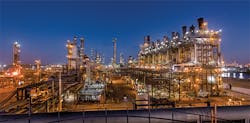ExxonMobil plans Blue H2 production plant on Gulf Coast
ExxonMobil has planned a hydrogen production plant and carbon capture project at its Baytown olefins plant in Texas that will support its efforts to reduce emissions from its operations.
Project planning and evaluation is underway and subject to stakeholder support, regulatory permissions and market conditions. A final investment decision on the project is expected in two to three years.
The facility will have a daily “blue” hydrogen production capacity of up to 1 billion cubic feet. “Blue hydrogen” is produced from natural gas, while being supported by carbon capture and storage.
“Hydrogen has the potential to significantly reduce CO2 emissions in vital sectors of the economy and create valuable, lower-emissions products that support modern life," ExxonMobil Low Carbon Solutions’ President Joe Blommaert explained. The ExxonMobil Low Carbon Solutions business focuses on carbon capture and storage, hydrogen and biofuels.
Blommaert added, “By helping to activate new markets for hydrogen and carbon capture and storage, this project can play an important part in achieving America’s lower-emissions aspirations.”
Using hydrogen at the plant could result in an estimated 30% reduction in Scope 1 and 2 emissions at the plant and support the firm’s goal of achieving net-zero GHG emissions across operations by 2050. Additionally, the site will be used to manufacture lower-emissions products for its customers and any surplus hydrogen and CO2 storage capacity would be available to nearby industry.
Moreover, the project, will be the firm’s initial contribution to a cross-industry effort to establish a Houston carbon capture and storage hub. The initial target of the hub will be approximately 50 million metric tons of CO2 annually by 2030 and 100 million metric tons by 2040.
The Baytown carbon capture project is expected to be among the world’s largest.
ExxonMobil already produces approximately 1.5 billion cubic feet of hydrogen per day and has captured more human-made CO2 than any other firm. It holds about one-fifth of the world’s carbon capture and storage capacity, which is approximately 9 million metric tons annually.
The company intends to invest over $15 billion over the next six years in initiatives aimed at lowering emissions and advancements in policy and technology.
About the Author
EnergyTech Staff
Rod Walton is head of content for EnergyTech.com. He has spent 17 years covering the energy industry as a newspaper and trade journalist.
Walton formerly was energy writer and business editor at the Tulsa World. Later, he spent six years covering the electricity power sector for Pennwell and Clarion Events. He joined Endeavor and EnergyTech in November 2021.
He can be reached at [email protected].
EnergyTech is focused on the mission critical and large-scale energy users and their sustainability and resiliency goals. These include the commercial and industrial sectors, as well as the military, universities, data centers and microgrids.
Many large-scale energy users such as Fortune 500 companies, and mission-critical users such as military bases, universities, healthcare facilities, public safety and data centers, shifting their energy priorities to reach net-zero carbon goals within the coming decades. These include plans for renewable energy power purchase agreements, but also on-site resiliency projects such as microgrids, combined heat and power, rooftop solar, energy storage, digitalization and building efficiency upgrades.
